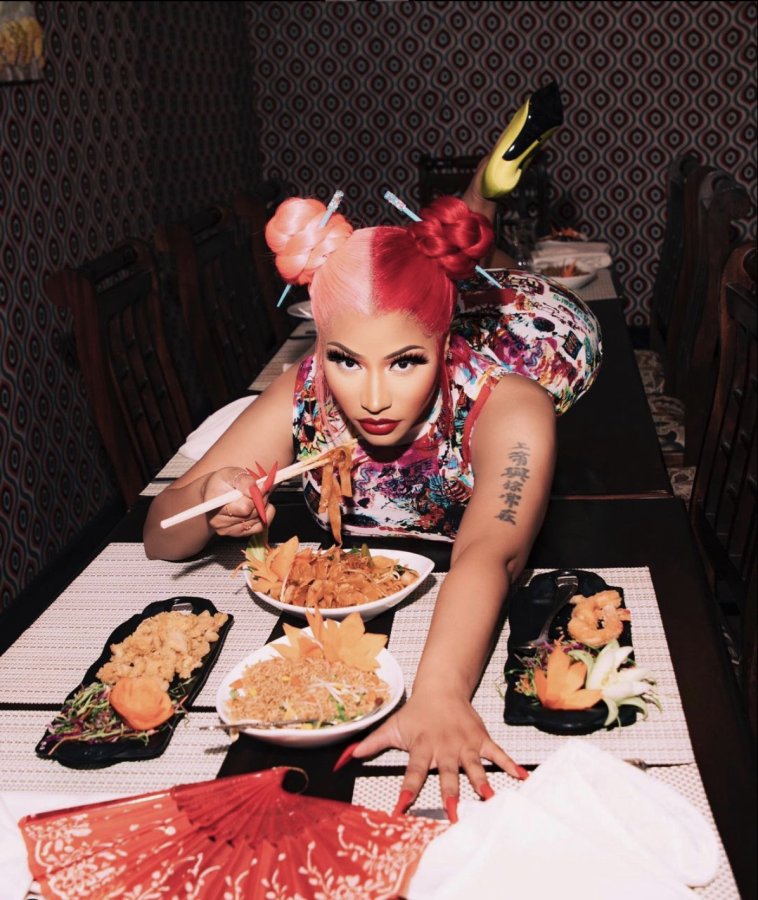Opinion | Why Nicki Minaj is more problematic than you thought | Part I
Photo courtesy of @nickiminaj / Instagram
Rapper Nicki Minaj lies on top of a table eating Chinese food with a pair of chopsticks. Symbols of Asian culture are prevalent in the photo: her hairstyle has chopsticks stuck through double hair buns, there is a Chinese folding fan and she is showing her tattoo, which is in Chinese script. Columnist Vidhi Patel uses the example of Nicki Minaj to highlight how fame does not absolve people from accountability.
Mar 16, 2023
*Trigger warning: This column discusses rape.*
Rapper Nicki Minaj has been a prominent figure in music for more than a decade. She has been a trailblazer for women in hip-hop and Black women in the music industry. She has won many awards and her old hits have gained even more popularity on TikTok. Therefore, it is no surprise that she has sustained a strong fan base — referred to as the Barbz — over the years.
However, there is a lot of controversy and problematic behavior surrounding Minaj that most people ignore in their admiration of her music and style. In light of her new single, it is important to outline incidents of Minaj’s racism in the past — and the present.
In 2018, Minaj released a song called “Chun-Li,” named after a character in the video game “Street Fighter II.” The song’s music video sexualizes and stereotypes East Asian women and East Asian culture in many ways. The video starts out with a gong sound and shows Minaj and others in racist East Asian garb. Minaj has chopsticks stuck through double hair buns while the men around her wear conical “rice hats” that are often used in anti-Asian imagery.
She says in the song, “I went and copped the chopsticks/ Put ‘em in my bun just to pop shit.” While the game character Chun-Li has her hair in two buns, the chopsticks were Minaj’s own creative decision, further creating a caricature of East Asian women.
Get The Daily Illini in your inbox!
People often defend this video with the argument that Chun-Li is a character, not a creation borne from Minaj’s own racism. What they ignore is that Minaj cosplaying as a racist, sexualized depiction of a Chinese woman does not excuse her from accountability — while she did not create the character, she is spreading it.
This was not the first time that Minaj appropriated Asian culture for her brand. One of her many “alter egos” she personifies in songs and music videos is Harajuku Barbie, named after a district in Tokyo. In an MTV interview, she said, “I was calling myself the Harajuku Barbie because a lot of girls on MySpace at that time — this was when MySpace was really big — were calling themselves ‘something Barbie’ and I wanted mine to be really unique and different.”
Imagine if a white celebrity began to brand themselves as “Shanghai Barbie” or “Tokyo Barbie” despite having no real connections with that city, while simultaneously using that culture over and over for their own brand.
In 2017, Minaj released a holiday clothing collection with H&M, including a kimono with cherry blossom and paper fan imagery. To further emphasize her “inspiration” for this line, the branding and tags all have her name written in Japanese kanji.
The argument can no longer be made that she is simply appreciating Japanese culture. Minaj is explicitly capitalizing on an entire culture that is not her own.
She has called out high-end fashion designers for exploiting Black culture without inclusion or representation, yet does the same with Asian culture and faces no consequences for her actions.
Furthermore, Minaj faced further backlash in 2017 for posting a cartoon of herself in the style of Disney’s Pocahontas engaging in a sexual act with another cartoon depiction of herself. The image is disturbing considering that Pocahontas was a child at the time of her interactions with Virginia settlers. But the real history of Pocahontas as a rape victim makes Minaj’s sexual cartoon even more tone-deaf.
The history and realities of Indigenous women’s experience with sexual violence makes something like this, even as a joke, inexcusable. However, this explicit sexualization and fetishization of Pocahontas has been swept away in the deafening cries of her supporters.
Inevitably, people will excuse Minaj’s behavior by saying it was all in the past — although being racist wasn’t okay in 2018, either. However, Minaj continues to reinforce racist stereotypes to this day.
On March 3, Minaj released a new single called “Red Ruby Da Sleeze,” which she has been promoting on her Instagram with images of herself surrounded by East Asian cultural imagery. The song itself was not as heavy on cultural appropriation as her previous works, but she still included some Chinese references in the lyrics and lyric video.
She continues to excessively capitalize on a culture that is not her own for her business.
Minaj’s list of problematic behavior is unfortunately too long to cover in one column. Part two will address her public support for criminals and sex offenders.
Vidhi is a sophomore in LAS.






